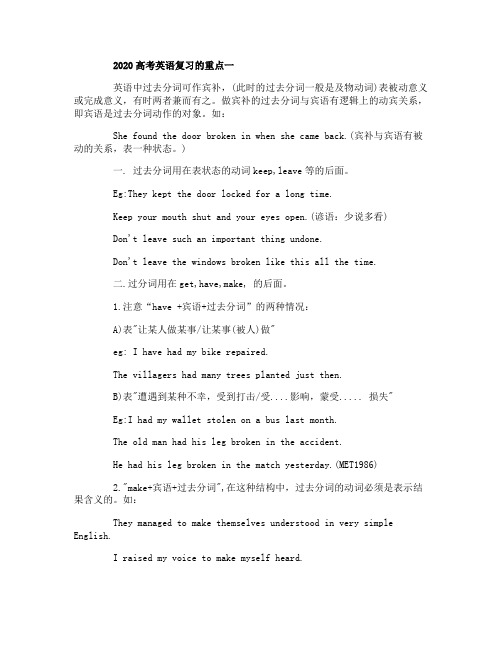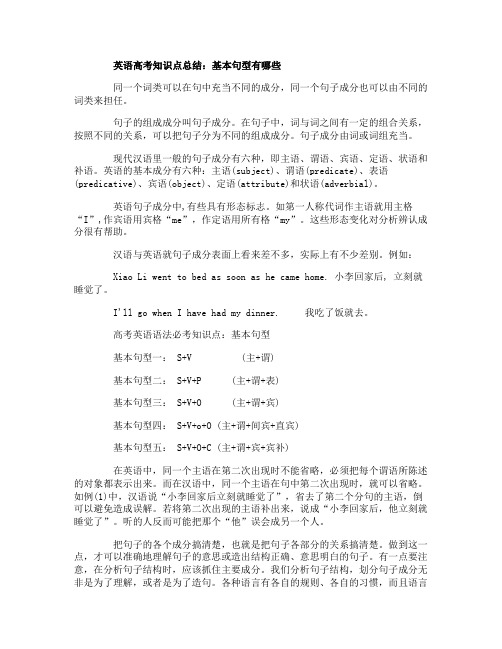2020高考英语考点汇总
- 格式:pdf
- 大小:2.13 MB
- 文档页数:74

专题01名词——高效演练一.单句语法填空1.The__________ (possible)that there is life on other planets in the universe has always inspired scientists to explore the outer space.【答案】possibility【解析】考查名词词义辨析及语境理解。
句意:宇宙中其它星球上存在生命这种可能性总是激励科学家们去探索外部空间。
故填possibility。
2. Try to understand what’s actually happening instead of acting on the _______ (assume)you’ve made.【答案】assumption【解析】考查名词词义辨析及语境理解。
句意:试着去理解实际发生的事情,而不是按照你所做的假设行事。
故选assumption 。
3.In 1863 the first underground passenger railway in the world opened in London. It ran for just under seven kilometers and allowed people to avoid terrible (crowd) on the roads above as they travelled to and from work. 【答案】crowds【解析】考查名词。
crowd前没有冠词、指示代词和形容词性人称代词,故用复数形式。
4.But for tourists like me,pandas are its top ________(attract).【答案】attraction【解析】句意:但是对于像我一样的游客来说,大熊猫是最大的吸引。
形容词top“头等的;最重要的”后面跟名词形式。

专题一名词和冠词常考点掌握名词的可数和不可数性、可数名词的复数、名词作定语以及名词的所有格形式的用法。
特别注意名词词义辨析和名词固定短语的运用。
近些年考查名词的题目,在设问方面更趋精细化。
冠词主要考查牢固的基础知识和灵活使用冠词的能力。
冠词的用法复杂,要弄清句子中的单数名词、复数名词或不可数名词的泛指、特指、类指、专指的概念。
做题时,首先要搞清名词是单数还是复数,是特指还是泛指,注意复数名词、不可数名词表示泛指不用任何冠词,单数名词前要加不定冠词。
名词1名词的数1. 单数名词变为复数名词常考点:①以-o结尾的名词变为复数时,常在词尾加-s,但是下列以-o结尾的名词要加-es:hero,tomato,potato,Negro(黑人)。
②以-f或-fe结尾的名词变为复数时,一般直接加-s,但下列以-f或-fe结尾的名词变为复数时,需把f或fe去掉,加-ves:half,-self,wife,life,knife,shelf,wolf,thief,leaf,loaf。
③合成名词构成复数时,通常只将里面所含的主体名词变为复数,如果没有主体名词,则将最后一部分变为复数。
如:passers-by,go-betweens,lookers-on,mothers-in-law。
2. 下列名词通常作不可数名词:fun,advice,progress,information,equipment,luggage,weather,furniture等。
3. 有些名词的复数形式可表示特别的意义。
如:waters(水域),sands(沙滩),manners(礼貌),times(时代),spirits(情绪;烈酒),contents(目录),customs(海关),lines(台词),arms(武器),looks(容貌)。
4. 单复数同形的名词。
如: Chinese,Japanese,sheep,deer,series,means,works。


2020高考英语复习的重点一英语中过去分词可作宾补,(此时的过去分词一般是及物动词)表被动意义或完成意义,有时两者兼而有之。
做宾补的过去分词与宾语有逻辑上的动宾关系,即宾语是过去分词动作的对象。
如:She found the door broken in when she came back.(宾补与宾语有被动的关系,表一种状态。
)一. 过去分词用在表状态的动词keep,leave等的后面。
Eg:They kept the door locked for a long time.Keep your mouth shut and your eyes open.(谚语:少说多看)Don't leave such an important thing undone.Don't leave the windows broken like this all the time.二.过分词用在get,have,make, 的后面。
1.注意“have +宾语+过去分词”的两种情况:A)表"让某人做某事/让某事(被人)做"eg: I have had my bike repaired.The villagers had many trees planted just then.B)表"遭遇到某种不幸,受到打击/受....影响,蒙受..... 损失"Eg:I had my wallet stolen on a bus last month.The old man had his leg broken in the accident.He had his leg broken in the match yesterday.(MET1986)2."make+宾语+过去分词",在这种结构中,过去分词的动词必须是表示结果含义的。
如:They managed to make themselves understood in very simple English.I raised my voice to make myself heard.三、过去分词用在感观动词watch,notice,see,hear,listento ,feel,find等后面。

英语高考知识点总结:基本句型有哪些同一个词类可以在句中充当不同的成分,同一个句子成分也可以由不同的词类来担任。
句子的组成成分叫句子成分。
在句子中,词与词之间有一定的组合关系,按照不同的关系,可以把句子分为不同的组成成分。
句子成分由词或词组充当。
现代汉语里一般的句子成分有六种,即主语、谓语、宾语、定语、状语和补语。
英语的基本成分有六种:主语(subject)、谓语(predicate)、表语(predicative)、宾语(object)、定语(attribute)和状语(adverbial)。
英语句子成分中,有些具有形态标志。
如第一人称代词作主语就用主格“I”,作宾语用宾格“me”,作定语用所有格“my”。
这些形态变化对分析辨认成分很有帮助。
汉语与英语就句子成分表面上看来差不多,实际上有不少差别。
例如:Xiao Li went to bed as soon as he came home. 小李回家后, 立刻就睡觉了。
I'll go when I have had my dinner. 我吃了饭就去。
高考英语语法必考知识点:基本句型基本句型一: S+V (主+谓)基本句型二: S+V+P (主+谓+表)基本句型三: S+V+O (主+谓+宾)基本句型四: S+V+o+O (主+谓+间宾+直宾)基本句型五: S+V+O+C (主+谓+宾+宾补)在英语中,同一个主语在第二次出现时不能省略,必须把每个谓语所陈述的对象都表示出来。
而在汉语中,同一个主语在句中第二次出现时,就可以省略。
如例(1)中,汉语说“小李回家后立刻就睡觉了”,省去了第二个分句的主语,倒可以避免造成误解。
若将第二次出现的主语补出来,说成“小李回家后,他立刻就睡觉了”。
听的人反而可能把那个“他”误会成另一个人。
把句子的各个成分搞清楚,也就是把句子各部分的关系搞清楚。
做到这一点,才可以准确地理解句子的意思或造出结构正确、意思明白的句子。

2020年高考英语语法必考考点(9)数词及主谓一致【考点解读】一、数词1. 基数词(1)注意几个不规则的基数词的写法。
如eleven, twelve, thirteen, fifteen, twenty, thirty, forty, fifty等。
(2)注意英语中的数量以三位为一个单位,一般对应阿拉伯数字的写法每三位加一个逗号,分别是thousand, million和billion。
如:ten thousand=10,000; one hundred million=100,000,000。
(3)数词hundred, thousand, million, billion, dozen, score表示确切数目时不加-s,但若表示不确切数目时,要用复数形式,与of构成短语。
如:一万:ten thousand;成千上万的:tens of thousands of;两打鸡蛋:two dozen eggs。
(4)年代表达方式有两种写法。
如:20世纪90年代:in the 1990s或in the 1990’s。
2. 序数词(1)序数词前面一般加the,多数序数词由基数词加-th构成。
如:the fifteenth; 以y结尾的基数词变化时,先把y改成i,再加-eth。
如:twentieth。
注意几个不规则的序数词的写法。
如:first, second, third, fifth, eighth, ninth, twelfth等。
(2)序数词常可缩写,其形式为阿拉伯数字加序数词的最后两个字母。
如:1st, 2nd, 3rd, 4th, 21st, 22nd, 23rd, 24th。
3. 小数小数点用point表示,小数点后的数用个位基数词表示。
如:0.567-zero point five six seven。
4. 分数分子用基数词,分母用序数词,如果分子大于1,分母须加-s。
如:1/5-one fifth/one-fifth; 3/4-three fourths/three-fourths。
2020高考英语高频答案词高频考点必考点目录:一、高频答案词二、高频句型核心词三、高频核心短语(以介词和副词为中心)四、语法考点高频答案词五、阅读词汇题及完形熟词僻义高频考点一、2020高考英语高频答案词(十五)sso=therefore =thus =as a result =accordingly因此〖2006浙江〗Progress so far has been very good. , we are sure that the project will be completed on time.A.HoweverB.OtherwiseC.ThereforeD.Besideshowever不管怎样;otherwise否则;therefore所以;besides除此以外。
根据句意判断, 前后句为因果关系, 故C项正确。
〖2005全国I〗My parents will move back into town in a year or_____.A. laterB. afterC. soD. about时间+or so=about +时间。
〖答案〗Cso that(宾语从句后面有can)是解!〖2005北京〗I’d like to arrive 20 minutes early I can have time for a cup of tea.A.as soon asB.as a resultC.in caseD.so that句意为:我早到20分钟的目的是能有时间喝点茶。
as soon as一……就……, 引导时间状语从句;as a result结果;in case以免, 万一(发生……)。
故答案为so that。
〖2004全国I〗Roses need special care ______ they can live through winter.A. becauseB. so thatC. even ifD. as本题考查状语从句的引导词, 根据意思可知此句是目的状语从句。
2020高三英语重点知识点总结归纳三篇高三英语重点知识点总结1一、重要单词用法例析1. below prep. & adv. 在......下面,低于Do not write below the line. 不要该横线下写字。
I live on the floor below. 我住在下一层。
2. concentrate vt. & vi. 集中于,专注I tried my best to concentrate my thoughts on the problem. 我努力让自己集中思想在这个问题上。
3. meanwhile adv. 在此其间,与此同时The train won’t leave for an hour. Meanwhile we can have lunch. 火车还有一个小时才开,其间我们可以吃中饭。
Tom was at home studying. Meanwhile, Jon was out playing. Tom在家学习,与时同时Jon外出玩耍。
搭配:in the meanwhile同时,在此期间In the meanwhile I’ll visit an old friend of mine. 在这期间我将去拜访我的一位老朋友。
4. gifted adj. 有天分的; 有天赋的He is a gifted musician. 他是天才音乐家。
5. seldom adv. 很少There is seldom snow in Guangdong. 广东很少下雪。
He seldom goes out on Sundays, does he? 星期天他很少出去,对吗?Seldom has there been such a happy meeting. 过去很少有过这样愉快的会议。
注意:(1)其后的反意疑问句用肯定式;(2)位于句首时,谓语用部分倒装。
2020高考英语高频答案词高频考点必考点目录:一、高频答案词二、高频句型核心词三、高频核心短语(以介词和副词为中心)四、语法考点高频答案词五、阅读词汇题及完形熟词僻义高频考点四、语法考点高频答案词(一)(按选项出现的频度高低排列)【1】that1.引导名词性从句,只起连接作用,无具体意义。
A story goes that Elizabeth I of English liked nothing more than being surrounded by clever and qualified noblemen at court.2.关系代词,用于限制性定语从句。
Is this the reason that he explained at the meeting for his carelessness in his work?3.程度副词,等于so. Sometimes it was a bit boring to work there because there wasn’t always that much to do.4.用于强调句型中,起连接作用。
What is it that you want me to say?5.替代词,既可替代可数名词,表特指;又可替代不可数名词,后接of。
I’m moving to countryside because the air there is much fresher than that in the city.【考例1】The traditional view is__we sleep because our brain is “programmed” to make us do so.A. whenB. whyC. whetherD. that (D) 【考例2】-----Where did you get to know her?------It was on the farm______we worked.A. thatB. thereC. whichD. where (A) 【考例3】Little joy can equal_______of a surprising ending when you read stories.A. thatB. thoseC. anyD. some (A) 【考例4】Having checked the doors were closed, and _____all the lights were off, the boy opened the door to his bedroom.A. whyB. thatC. whenD. where (B) 【考例5】----He got his first book published. It turned out to be a bestseller.-----When was____?------_____was in 2000 when he was still in college.A. that; ThisB. this; ItC. it; ThisD.that; It (D)【2】what1.引导名词性从句,担任句子成分。
英语高考知识点2020高中英语是中国高考的重要科目之一,它考察学生对英语语法、词汇、阅读理解等多方面的掌握程度。
正确的备考方法和对于高考知识点的准确理解对于考生来说至关重要。
本文将详细介绍2020年英语高考的主要知识点,以帮助学生更好地备考。
(第一部分:语法)高考英语语法部分主要考查学生对基础语法知识的理解和运用能力。
以下列举几个常见的语法知识点:1. 主谓一致:在句子中,主语与谓语动词在人称和数上要保持一致,例如“She goes to school every day.”(她每天去学校)。
2. 时态和语态:要熟练掌握英语中的各种时态,并理解不同时态的用法。
同时,要熟悉主动语态和被动语态的转换和使用。
3. 从句和复合句:了解主从句的概念,并注意从句与主句之间的连词使用和语序问题。
4. 形容词和副词的用法:掌握形容词和副词的比较级和最高级的构成和用法。
(第二部分:词汇)词汇是英语学习的基础,也是高考中的重要组成部分。
以下是几个值得注意的词汇知识点:1. 同义词和反义词:了解词语之间的近义关系和反义关系,并能准确运用。
2. 词汇搭配:学习常用词语的搭配,如“take a shower”(洗澡)、“make a decision”(做决定)等。
3. 词根词缀:了解常见的词根和词缀,并能根据其意义推测单词的含义。
(第三部分:阅读理解)阅读理解是高考英语的重中之重,考查学生的阅读能力和理解能力。
以下是一些值得注意的阅读理解知识点:1. 阅读技巧:学会快速浏览文章,注意段落和句子之间的逻辑关系。
2. 主旨观点:理解文章的主旨和作者的观点,通过理解关键信息来回答问题。
3. 推理判断:根据提供的信息,进行推理和判断,准确回答问题。
以上是英语高考的主要知识点,希望对于备考的同学们有所帮助。
只有通过对知识点的深入理解和熟练掌握,才能在考试中取得好成绩。
祝愿同学们在2020年的高考中取得优异的成绩!。
2020高考英语考点总结
目录:
一、重点单词
二、重点词组
三、高级词汇
四、词组固定搭配
五、高级句型结构
六、过去完成时概念
七、阅读理解解题指导
一、重点单词
1.able用法:beabletodo Note:反义词unable表示不能,而disabled表示残疾的。
beabletodo可以表示经过艰难困苦才能做到的事。
2.abroad用法:表示到(在)国外,是一个副词,前面不加介词。
Note:可以说fromabroad,表示
从国外回来。
3.admit用法:表示承认的时候
后面要加上动名词形式。
Note:表示允许进入的时候与介
词to搭配。
4.advise用法:advisesb.todo;advisedoing Note:后面的宾语从句要用虚拟
语气。
即:advisethatsb.(should)do的形
式。
5.afford用法:通常与动词不定
式搭配使用。
Note:前面需要有beableto或
can等词。
6.after用法:表示在时间、空间之后;beafter表示追寻。
Note:用在将来时的时候后面接一时间点,而in接一个时间段,如:after3o’clock;in3days.
7.agree用法:与介词
on,to,with及动词不定式搭配。
Note:agreeon表示达成一致;agreeto表示批准;agreewith 表示同意某人说的话。
8.alive用法:表语性形容词,在句中只能作表语,不能作定
语。
Note:可以作状语使用,表示活
活地,如:burysb.alive.
9.allow用法:
allowdoing;allowsb.todo Note:可以表示允许进入,如:Pleaseallowmein.
10.among用法:用在三者或三者
以上的群体中。
Note:还可以表示其中之一,如:Heisamongthebest.
11.and用法:用于连接两个词、短语、句子或其他相同结构。
Note:与祈使句搭配时往往可以
表示条件。
如:Workhard,andyou’llsucceeds
oonerorlater.
12.another用法:表示又一个,泛指,相当于onemore的含义。
Note:不能直接加复数名词,需要与一个数词搭配,如:
another2weeks.
13.answer用法:及物动词,但在作名词时要与介词to搭配。
Note:可以表示接电话、应门等。
如:answerthephone/door.
14.anxious用法:
beanxiousfor/about/todo Note:beanxiousabout表示担心;beanxiousfor表示盼望得
到。
15.appear用法:不及物动词,没有宾语,没有被动语态。
Note:还可以作为系动词,与seem同义,表示看起来……。
16.arrive用法:arriveat表示到一个小地方;arrivein表示到
一个大地方。
Note:引申含义表示得出,如:arriveatadecision/conclusio
n.
17.ask用法:asktodo;asksb.todo;askfor Note:后面的宾语从句要用虚拟
语气。
即:askthatsb.(should)do的形式。
18.asleep用法:表语性形容词,在句中只能作表语,不能作定
语。
Note:通常与动词be及fall搭配;soundasleep表示熟睡。
19.attend用法:表示参加,后
面经常加上meeting,lecture,conference, class,school,wedding,funera l等词;也可以表示照顾,照料。
Note:attendto可以表示处理、
照料等。
20.attention用法:payattentionto;draw/catchsb
’sattention
Note:写通知时的常用语:MayIhaveyourattention,pleas
e?
21.beat用法:表示打败某人,
或连续不断地击打某物。
Note:heartbeat表示心跳。
22.because用法:后面接原因状语从句,becauseof后面接名词。
Note:because表示直接原因,因此只有用它才可以回答why的特
殊疑问句及用在强调句中。
23.become用法:系动词,表示变得……。
可以由好变坏或由坏
变好。
Note:becomeofsb.表示某人发
生了什么事情。
24.before用法:beforelong,longbefore,theda ybeforeyesterday,theweek/ye
arbeforelast上上周/前年Note:Itbe+段时间before…在该句型中,主句时态只有将来时态和一般过去时态。
25.begin用法:
begintodo;begindoing Note:当begin本身是进行时的时候,只能用begintodo的形式。
如:Itwasbeginningtorain. 26.believe用法:believesb.
表示相信某人说的话;believeinsb.表示信任;6123
结构。
Note:回答问句时通常用
Ibelieveso/not的形式。
27.besides用法:表示除……之外还有,包含在一个整体之中。
Note:还可以用作副词,表示此外,要用逗号隔开。
28.beyond用法:表示越过、在
另一边,如:
beyondthewood/bridge. Note:可以用于引申含义,表示
超出……,如:beyondcontrol/power/descrip
tion.
29.bit用法:与alittle一样可以修饰不可数名词,形容词或副
词。
Note:修饰名词时要用abitof;
notabit表示一点也不。
30.blame用法:
take/beartheblame;blamesth.
on.sb.
Note:表示应受到责怪时不用被动语态,如:Heistoblame. 31.blow用法:blowdown/away
Note:表示风刮得很大时要用
blowhard.
32.boil用法:boiling表示沸腾的;boiled表示煮过的。
Note:boilingpoint可以表示沸
点。
33.borrow用法:borrow表示借
入:lend表示借出。
Note:点动词,不能表示借的时
间长短。
34.breath用法:holdone’sbreath;outofbreat h;saveone’sbreath Note:takeabreath表示深吸一口气;takebreath表示喘口气。
35.burn用法:
burndown/up/one’shand Note:burning表示点着的;
burnt表示烧坏的。
36.business用法:onbusiness 表示出差;in/outofbusiness
表示开/关张。
Note:表示商业时不可数,表示。